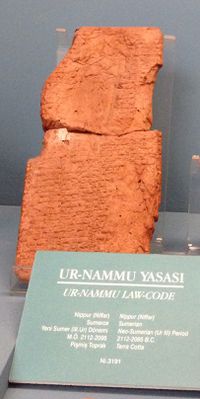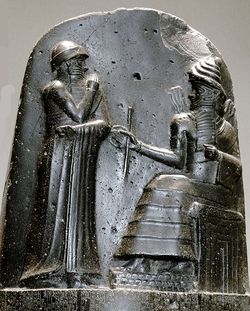How Did Early Judicial Systems Evolve
We think today that an effective judicial system is necessary for any society to function and provide justice to its citizens. The concept of justice, in fact, has evolved from very early written history, showing some similarities early on with modern ideas of law and justice for individuals. Laws and a formal judicial system developed over time in an attempt to punish crimes and regulate commerce.
Early Development
By the mid-third millennium BC, concepts of precedent and jurisprudence had developed, where judges would decide cases on civil and criminal matters. Laws were seen as a way to dispense justice, a key quality for kings in their service to the gods. Some of the earliest laws, although very likely even earlier laws existed, derive from the ancient Sumarian city of Lagash, located in southern Mesopotamia (southern Iraq), during the reign of Urukagina. The laws or edicts seem to have been written at around 2350 BC. [1] Remarkably, already at this early date there was a clear understanding of individual rights and checks to prevent the abuse of power by authorities. This included limits seizure of land by the temples, which were powerful institutions by this time, or wealthy individuals.[2] There was a check on state tax collection, while efforts were made to dispense justice in cases of murder and criminal actions such as theft. Unlike the later Laws of Hammurabi, there does not seem to be an emphasis on capital punishment for criminal actions. Cases of divorce were removed from state authority to a civil matter. The king even returned land and other property his predecessors had seized; the laws state that they are intended to protect the vulnerable in society, particularly widows and orphans. While these early laws are fragmentary, as the entire legal code and proceedings are not known, they do show that individuals were provided with rights to prevent abuse by authorities and to remove state authority from certain types of family matters.
On the other hand, some have suggested there is evidence that the laws also enshrined men’s authority in society. There seems to be a ban on polyandry, or marriage of multiple men by a woman, while no evidence indicates polygamy was banned. A punishment for adultery seems to have existed for women, but there is no evidence any punishment was enacted on men. Overall, scholars see these laws as an attempt to reform society, which may have become increasingly controlled by a limited number of authorities and abuse of common citizens became more common. The laws are seen to have attempted to rebalance power and provide protection to common citizens.[3]
The Laws of Ur-Nammu
The oldest formal law code (Figure 1), where the code was written as a legal text rather than kingly decrees such as the laws of Urukagina, is one attributed to king Ur-Nammu, who ruled the Ur III state from ancient Ur (located in southern Iraq). The law code may have been written sometime between 2100-2050 BC. The laws enshrine capital punishment in cases involving murder and theft, while fines and imprisonment were enacted in cases dealing with kidnapping. Fines were handed out in cases involving bodily injury, lying, or damaging someone’s property. The law code also introduces the “water ordeal,” which is similar to Medieval concepts of letting God, or in this case the gods, decide if someone is innocent or not. For instance, if someone is accused of sorcery then that person is thrown in water or probably a canal or river. If they survive, then they are innocent, while those who drown were guilty.
Interestingly, the concept of “eye for an eye” does not seem to be applied in the law code, as many offences were resolved through fines rather than equal harm. The law code shows that women did have some protection, including women receiving payment in cases of divorce, and were not assumed to be the guilty party in sexual crime, although it is clear justice was not the same for slaves and freepersons. In cases of rape of another man’s wife, then the perpetrator would be punished by death, while rape of a slave was punished through a fine. In fact, many of the surviving laws deal with slavery, including payments of money to people who recover slaves who escaped or if a son is born to a slave marrying a freeperson, then that son belongs to the freeperson owner.[4]
Later Laws and Hammurabi
Already by the early second millennium BC, between 2000-1800 BC, we begin to see law codes in cities such as Isin and Eshnunna in Mesopotamia. Many laws were focused on property issues, regulating trade, prices, equipment, while accidents and fines were also discussed. In many cases of sexual offences, theft, and bodily injury, it seems fines were more commonly used rather than simply harsher punishments.[5]
One of the most famous law codes, and for a long time seen as the oldest law code, was the law code attributed to Hammurabi (Figure 2), who ruled in Babylon in Mesopotamia. While the law code of Hammurabi is famous for having very harsh punishment in many decrees, including the death penalty, the law code was also enshrined as a form of constitution for citizens. It gave them rights and required evidence be produced when accusations were made and there is an assumption of innocence until sufficient evidence proved otherwise. Taking oaths before gods, the concept of using divine figures, which we have retained in our own laws, and justifying laws as a way to help the oppressed were justification for the code. However, the utilization of the water ordeal also shows superstition was sometimes used as a form of proof. The Hammurabi law is also well known for concepts of equal punishment for a given offence. Thus, the phrase “eye for an eye” first appears in Hammurabi’s laws. The laws seem to have been distributed to various parts of Hammurabi’s empire, suggesting it was intended as a type of national law, as multiple copies have been found. The code was organized into sections dealing with related matters, including topics dealing with slander, trade, criminal offences, slavery, workers’ duties, theft, food, family matters, liability, and divorce.[6] The laws, in many respects, incorporate some of the older Sumerian laws while also adopting Amorite custom, which was the cultural group associated with Hammurabi.[7]
However, no judicial case written has been found to indicate Hammurabi’s code was directly invoked. This suggests the law code may have also been an attempt to deter criminal behavior, as Hammurabi suggests lawlessness may have prompted the creation of the law code and the harsh laws were need to diminish criminality. Hammurabi also instructs officials to apply precedent as a foundation for law in his letters, which is again similar to modern concepts of judicial practice.[8] Finally, comparisons between the law code and the later Mosaic laws show some similar structures. For instance, the use of divine authority, the concept of an eye for an eye and tooth for a tooth, use of witnesses, and major concern with property are common to both laws. [9] This does not suggest that Hammurabi’s law necessarily influenced the later Biblical law, but it could suggest common shared culture across Mesopotamia and other Near East societies.
Other Near East States
We see throughout the 2nd millennium BC law codes appearing in the ancient Near East, including in the Hittite Empire located in Anatolia. These laws cover assault, marital relationships, theft, contracts, and sexual relationships. In most cases, there is an aversion for the death penalty and fines or enslavement for serious cases were applied. Slavery, similar to how it was applied in Mesopotamia, was utilized as a form of penal system. [10] The Assyrian laws also were encoded at about the same time. These laws, however, were far more gruesome in punishment, with offenders often having noses and ears chopped for even minor infractions. In cases of murder, the families of the victim were able to choose how the perpetrator was put to death.[11]
Conclusion
Certainly we should expect other societies, such as in the Indus or ancient Egypt, to have had major law codes, although these did not survive or have not left understood records for us. What the early Mesopotamia records show is that concepts of witnesses, using judges, protecting the oppressed, individual’s rights, legal frameworks and precedent, law as having divine origin, and a variety of punishments, including imprisonment and fines, had developed early in complex societies.
References
- ↑ For more general information on Urukagina’s early laws, see: VerSteeg, Russ. 2000. Early Mesopotamian Law. Durham, N.C: Carolina Academic Press, pg. 18.
- ↑ For further information on such early Mesopotamian states and laws, see: Yoffee, Norman. 2004. Myths of the Archaic State: Evolution of the Earliest Cities, States and Civilizations. New York: Cambridge University Press, pg. 103.
- ↑ For summary of the laws of Urukagina, see: Kramer, Samuel Noah. 1995. The Sumerians: Their History, Culture, and Character. 12. [pr.]. Chicago: The Univ. of Chicago Press.
- ↑ For information and definitive study on the laws of Ur-Nammu, see: Code of Ur-Nammu. 2012. [Place of publication not identified]: Book On Demand.
- ↑ For more information on Mesopotamia laws, see: Roth, Martha Tobi, Harry A. Hoffner, and Piotr Michalowski. 1997. Law Collections from Mesopotamia and Asia Minor. 2. ed. Writings from the Ancient World, vol. 6. Atlanta, Ga: Scholars Press.
- ↑ For more information on the law code of Hammurabi, see: Horne, Charles F, C. H. W Johns, and L. W King. 2007. The Code of Hammurabi. Lexingston, KY: Forgotten Books.
- ↑ For more information about the inspirations for Hammurabi’s laws, see: Tetlow, Elisabeth Meier. 2004. Women, Crime, and Punishment in Ancient Law and Society. New York: Continuum, pg. 53.
- ↑ For more information on Hammurabi’s application of law, see VerSteeg 2000, pg. 16.
- ↑ For more information on comparisons between Mosaic and Hammurabi’s law, see: Davies, W. W, and Hammurabi. 2009. The Codes of Hammurabi and Moses: With Copious Comments, Index and Bible References. Cincinnati, Ohio; New York: Jennings and Graham ; Eaton and Mains.
- ↑ For information on Hittite laws, see: Hoffner, Harry A. 1997. The Laws of the Hittites: A Critical Edition. Documenta et Monumenta Orientis Antiqui, v. 23. Leiden ; New York: Brill.
- ↑ For information on the Assyrian laws, see: Saporetti, C. 1984. Middle Assyrian Laws. Cybernetica Mesopotamica. Malibu: Undena Publications.
Admin, EricLambrecht and Maltaweel


